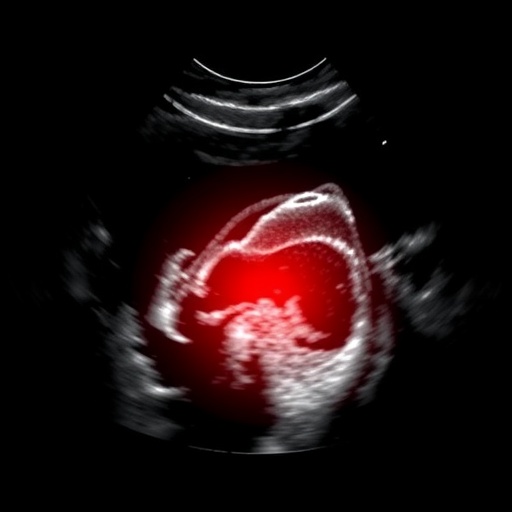In the realm of pediatric medicine, acute abdominal pain remains one of the most prevalent issues that healthcare professionals encounter. The diagnostic approach to these cases requires a blend of clinical acumen and advanced imaging techniques. A recent study led by Kavari, Sadegh, and Vafa illuminates the pivotal role of ultrasound in diagnosing conditions associated with acute abdominal pain in children. Conducted at a tertiary center in Southern Iran, this cross-sectional study sheds light on the efficacy of ultrasound, an imaging modality that is non-invasive and devoid of ionizing radiation, making it particularly suitable for the pediatric population.
The significance of ultrasound in pediatric care cannot be overstated. Children are not merely little adults; their physiological responses and presentations can differ significantly from those of older patients. In cases of abdominal pain, distinguishing between benign and serious conditions promptly is paramount to ensure appropriate management. The ability of ultrasound to visualize organs and potential pathologies in real-time enables clinicians to make swift decisions regarding the necessity for surgical interventions or further investigations.
In their study, the researchers meticulously gathered data from a diverse cohort of patients presenting with acute abdominal pain. The thoughtful design of the study ensured that the findings could be generalized to similar settings, providing essential insights for clinicians worldwide. The cohort included a variety of abdominal pain presentations, reflecting the complexity of issues that can arise in a pediatric population, ranging from appendicitis to more rare conditions such as intussusception.
The study highlighted the importance of clinical history and physical examination, which are foundational in pediatric assessments. However, as the researchers pointed out, these traditional methods may not always yield clear answers, necessitating the integration of imaging techniques such as ultrasound. The investigators systematically evaluated the accuracy of ultrasound findings, correlating results with clinical outcomes and additional diagnostic procedures, including surgical findings when applicable.
A striking finding from the research underscored the high sensitivity and specificity of ultrasound in detecting various abdominal pathologies. For instance, in cases of suspected appendicitis, ultrasound proved to be an invaluable tool, enabling clinicians to identify inflamed appendices with remarkable precision. The nuances of such findings were discussed in detail, noting that the absence of inflammation on ultrasound could effectively guide clinicians away from unnecessary surgical explorations, thus reducing morbidity associated with surgery.
Moreover, the utility of ultrasound extends beyond simple assessment; it also plays a significant role in guiding therapeutic interventions. The researchers discussed scenarios where ultrasound could assist in procedures such as abscess drainage or the administration of specific medications. This aspect of ultrasound’s utility champions a more holistic approach to pediatric care, one that minimizes invasiveness and enhances patient comfort and safety.
One cannot overlook the implications of time efficiency in acute settings. The rapid turnaround time for ultrasound results can vastly improve the management of acute abdominal pain. In their findings, the authors emphasized that the swift diagnosis afforded by ultrasound could lead to timely interventions and improved outcomes, particularly critical in cases involving conditions like torsion or perforation.
Despite its many advantages, the study did not shy away from addressing potential limitations of ultrasound. Factors such as operator dependency and body habitus can influence accuracy, and the authors acknowledged that advanced imaging modalities, while not commonly first-line in pediatrics, still have a place in the diagnostic algorithm. Their balanced approach encourages clinicians to remain vigilant and consider the broader clinical picture when interpreting ultrasound results.
As the researchers concluded, the findings from this study advocate for a paradigm shift in how acute abdominal pain is approached in pediatric patients. By underscoring the strengths of ultrasound as a first-line diagnostic tool, they set the stage for further research and potential protocol development aimed at standardizing the use of ultrasound in such scenarios. The integration of ultrasound into standard practice could significantly alter the landscape of pediatric emergency medicine, offering a pathway towards enhanced diagnostic accuracy and patient care.
The implications of this study extend far beyond the walls of the tertiary center in Southern Iran, resonating with practitioners in resource-limited settings where access to advanced imaging may be restricted. Emphasizing a cost-effective and accessible method for diagnosis, the study propels the notion that ultrasound could be a game changer in ensuring timely care for children experiencing acute abdominal pain, irrespective of geographic boundaries.
In the age of personalized medicine and patient-centered care, the findings from Kavari and colleagues resonate with a broader audience in the medical community. As healthcare evolves, the necessity for adaptable, effective, and child-friendly diagnostic modalities will become increasingly crucial. This study illustrates the potential of ultrasound to fulfill these needs while setting a benchmark for future research endeavors aimed at optimizing pediatric care.
As we reflect on the findings, it is essential to embrace continuous education and training for healthcare professionals. The evolution of ultrasound technology and its applications in pediatric care invite ongoing exploration and understanding, ensuring that healthcare providers are equipped to utilize these advancements effectively. The collaboration between radiologists and pediatricians can foster an environment of shared knowledge, ultimately enhancing diagnostic capabilities and patient outcomes.
Ultimately, the work of Kavari, Sadegh, and Vafa is a clarion call to the medical community, urging a broader understanding and application of ultrasound in pediatric emergency settings. By bridging the gap between clinician intuition and technological capabilities, we can pave the way for enhanced diagnostic journeys that prioritize child safety and well-being, reaffirming our commitment to delivering the highest standards of care to our youngest patients.
This research not only contributes to the existing literature but also serves as a springboard for future investigations that can further elucidate the role of ultrasound in pediatric diagnostics. As we await the future findings stemming from this pivotal study, it remains clear that the integration of innovative diagnostics such as ultrasound will forge paths toward improved care practices and health outcomes for pediatric patients enduring acute abdominal pain.
Subject of Research: Diagnostic value of ultrasound in pediatric acute abdominal pain.
Article Title: Diagnostic value of ultrasound in pediatric acute abdominal pain: a cross-sectional study from a tertiary center in Southern Iran.
Article References:
Kavari, M., Sadegh, R. & Vafa, R.G. Diagnostic value of ultrasound in pediatric acute abdominal pain: a cross-sectional study from a tertiary center in Southern Iran.
BMC Pediatr 25, 694 (2025). https://doi.org/10.1186/s12887-025-06059-9
Image Credits: AI Generated
DOI: 10.1186/s12887-025-06059-9
Keywords: Pediatric, ultrasound, acute abdominal pain, diagnostic imaging, medical research.
Tags: clinical acumen in pediatric diagnosticscross-sectional study on ultrasound efficacydiagnosing acute abdominal pain in childrendifferentiating benign and serious conditions in pediatricsimplications of ultrasound findings in abdominal painionizing radiation-free imaging optionsnon-invasive imaging techniques for childrenpediatric abdominal pain managementpediatric healthcare challengesreal-time organ visualization in childrenultrasound in pediatric medicineultrasound technology in pediatric care





